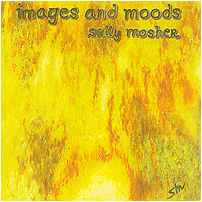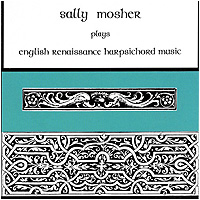| . | Home | Current CD's | Previous Releases | Videos | Photos | Paintings | CD Orders | Book Orders | Links | Contact |
|---|

presents... Sally Mosher | William Byrd: Songs · Dances · Battles · Games |
 |
| . | Home | Current CD's | Previous Releases | Videos | Photos | Paintings | CD Orders | Book Orders | Links | Contact |
|---|

presents... Sally Mosher | William Byrd: Songs · Dances · Battles · Games |
 |
A Bit of Harpsichord History
Two keyboard instruments appeared on the European musical scene during the 15th century – the clavichord and the harpsichord. The clavichord probably dates from the very beginning of the century, although the oldest surviving clavichords were made in Italy in the mid 16th century.
The earliest picture of a harpsichord dates from around 1450, and it is apparent from the picture that at that point the harpsichord’s mechanism was different from later instruments, since there is no jack rail. Italians are credited with the development of the instrument as we know it, but by the 16th century there were distinguished Flemish builders as well, most famously the Ruckers family.
Almost all the historical composers for harpsichord, from the first great composer, William Byrd of England (c. 1540-1623), and including the 18th century masters of the German and French Baroque, were organists. For the most part, they made their livings playing the organ, composing music for church and court, directing choirs, and teaching.
The English are especially associated with a type of harpsichord called a virginal. Contrary to popular mythology this is not because of the “Virgin Queen,” Elizabeth I, although she was a very proficient player on her Mother’s Italian-made virginal. Despite their famous association with the virginal, the English only began making their own virginals during the latter part of the 17th century.
In the Renaissance, harpsichords were most often used as solo instruments, their owners and players wealthy amateurs who played in private settings for their pleasure and that of a few friends. The great solo recital is a creature of the 19th century, and by then piano was the keyboard star. There were also court musicians who were employed just to play the harpsichord. One of the men executed along with Queen Elizabeth I’s virginal playing Mother, Anne Boleyn, accused of being her lover, was the court virginalist.
By Baroque times, harpsichords were used together with viola da gamba, and possibly a bass lute as well, to provide a harmonic and rhythmic underpinning (continuo) for other instruments in ensembles. The harpsichordist was sometimes the leader of the group, and was playing from a figured bass score. Many of these Baroque period harpsichords were exquisitely decorated, and a number still survive in playable condition in Europe.
The piano began to supplant the harpsichord in the last third of the 18th century. In general, by 1810 anyone who had been earning a living making harpsichords was either making pianos or out of business. Until the late 19th century, there ensued a period that I think of as “the long winter’s night” of the harpsichord. By the end of the 19th century, the stirring of interest in earlier music generated some interest in the harpsichord, but the 20th century resurrection of the harpsichord, first the “revival” instruments, and then our modern harpsichords, is a tale for another telling.
- Sally Mosher
Praise for William Byrd: Songs · Dances · Battles · Games
"Generosity of spirit and fine attention to detail ... a lovely combination
of old music faithfully reproduced, and the cultural context
provided by Mosher's notes, as welcome as they are rare."
--- Carolyn Kunin, Southern California Early Music News
"Beautifully recorded! If you don't know this music you should. Byrd
was the Great Master of English harpsichord and vocal music of the
Elizabethan age." --- The Harpsichord Center News
| Includes: | ||
| 1. 2. 3. 4. 5. 6. 7. 8. 9. 10. 11. 12. 13. 14. 15. 16. 17. 18. 19. 20. 21. 22. 23. 24. 25. 26. 27. |
Preludium The March Before the Battle (The Earl of Oxford's March) THE BATTLE: The Soldier's Summons The March of Footmen The March of Horsemen The Trumpets The Irish March The Bagpipe and the Drone The Flute and Drum The March to the Fight The Retreat The Burying of the Dead The Morris The Soldiers' Dance Galliard for the Victory Will You Walk the Woods So Wild Alman La Volta The Passing Measures (Ninth Paven) Galliard Jig Galliard's Jig First Paven First Galliard The Barley Break Callino Castaurame The Carman's Whistle |
|
| Total Time: 59:55 | ||
Catalog number: MP 101
Price: $15.99
For ordering information, click here.
Additional Releases by Sally Mosher
Click CD covers for more information
 |
 |
 |
||
| Sally Mosher: Images and Moods |
Sally Mosher: English Renaissance Harpsichord |
Sally Mosher: From Now On |
|---|
 |
 |
|
| Sally Mosher: Explorations |
Towards the Light Improvisations featuring Sally Mosher, Patrick Lindley, Justin Rizzo-Weaver, Scott Fraser |
|---|
© Copyright 1997-2011 New Mix Music
Webmaster's site: ElectricEarl.com